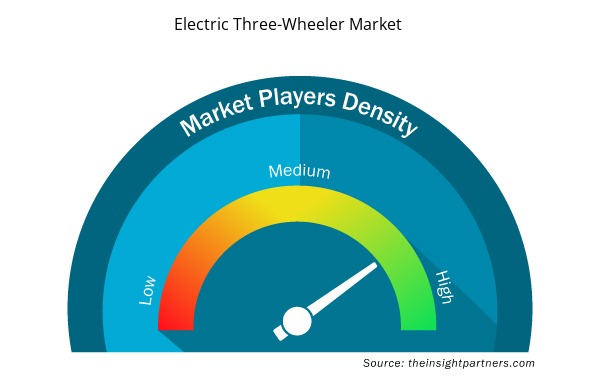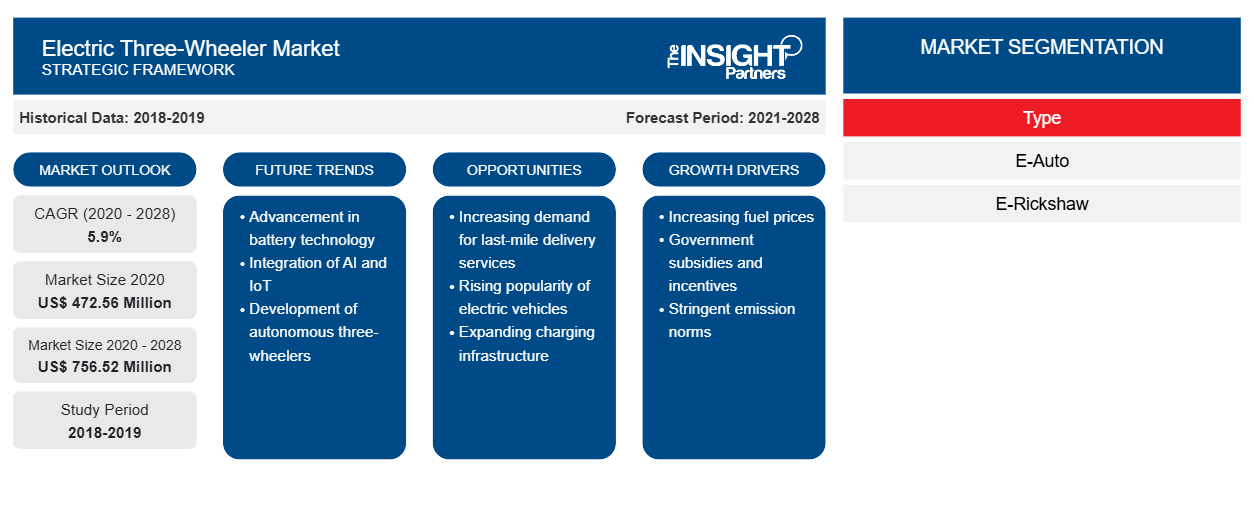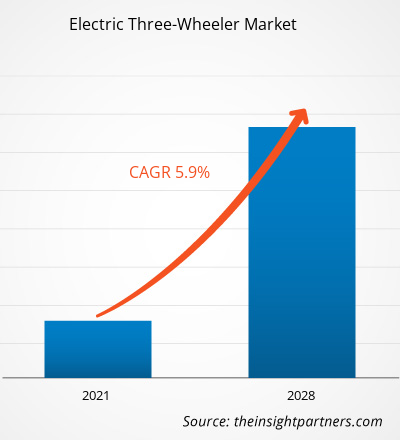2020 年电动三轮车市场价值为 4.7256 亿美元,预计到 2028 年将达到 7.5652 亿美元;预计 2021 年至 2028 年的复合年增长率为 5.9%。
电动三轮车广泛用于将乘客运送到目的地以及运输货物。这些三轮车由可充电电池驱动的电动机驱动。电池可以在电动充电站或任何其他相应的充电点充电。世界上许多低收入和中等收入国家三轮车的使用率较高,这些三轮车最初由内燃机 (IC) 驱动。但大多数内燃机三轮车效率低下且老旧。这导致制造商增加了对电动三轮车研发的支出。此外,电动三轮车在城市和郊区非常受欢迎,特别是在短时间内运送少量乘客和小型货物。推动电动三轮车市场增长的一些关键因素是政府对污染控制的严格规范和规定、人们对柴油车和汽油排放有害影响的认识不断提高以及对电动汽车的接受度不断提高。由于汽油和柴油是可耗尽的资源,人们已经开始考虑其他可能的替代品。电动三轮车已经开始取代汽油和柴油三轮车。电动三轮车的平均维护和运行成本远低于传统三轮车。然而,电池组重量大和行驶距离短是电动三轮车制造商面临的一些问题。电动三轮车在电池充满电的情况下行驶约 125-130 公里,而传统车辆在油箱满油的情况下行驶约 200-220 公里。
2020 年,亚太地区主导了电动三轮车市场 。印度是该地区电动三轮车市场最大的股东之一。在政府的有利举措以及 Mahindra & Mahindra、Atul Auto、Piaggio 和 Lohia Auto 等制造商的强劲表现的推动下,印度的低排放汽车行业正在迅速发展。混合动力和电动汽车快速采用和制造 II (FAME II) 计划的预算为 14 亿美元,其中将花费 11.9 亿美元用于提供电动汽车购买的前期折扣,并花费 190 万美元用于促进充电基础设施的实施。为了满足需求,这些措施将使 50 万辆电动三轮车受益。
定制此报告以满足您的需求
您可以免费定制任何报告,包括本报告的部分内容、国家级分析、Excel 数据包,以及为初创企业和大学提供优惠和折扣
- 获取此报告的关键市场趋势。这个免费样品将包括数据分析,从市场趋势到估计和预测。
COVID-19 疫情对电动三轮车市场的影响
COVID-19 疫情严重扰乱了电子设备(包括电动三轮车的硬件部件)的供应链和制造。鉴于 COVID-19 病毒在全球的出现以及随后的封锁情况,汽车行业专家预测,该行业将面临电子设备供应链至少四分之一的滞后。在政府取消各种遏制措施后,电子设备和汽车行业可能会很快加快步伐,这将有助于经济复苏。电子设备和汽车产品的生产预计将从 2021 年开始加快步伐,这预计将对电子设备和汽车制造(包括电动三轮车的硬件部件)产生积极影响。
市场洞察
有害气体水平、管理成本和清洁技术接受度不断提高
有害气体水平上升、管理成本和清洁技术的接受是电动三轮车市场增长的主要因素。采用电动汽车可以大大减少环境中污染物的排放,从而改善空气质量。为了最大限度地减少车辆燃料燃烧产生的温室气体排放,世界各地的监管机构都在提供税收优惠和激励措施,以增加环保型汽车的采用。几乎所有主要国家都宣布了补贴和财政激励措施,以吸引制造商在当地生产更多的电动汽车。此外,税收抵免和退税也吸引了许多当地用户购买电动汽车,到 2020 年,道路上的绿色汽车可能至少达到 60%,从而减少燃料排放并降低对石油产品的依赖。中国、印度、韩国、印度尼西亚和孟加拉国的监管机构一直在实施各种计划,以提高电动三轮车的销量。例如,2018 年 3 月,印度重工业和公共企业部启动了 FAME 印度计划第二阶段,该计划共获得 13.9 亿美元的预算支持。该阶段旨在通过补贴支持 500,000 辆电动三轮车、55,000 辆电动四轮乘用车、7,000 辆电动公交车和 100,000 辆电动两轮车。FAME 计划的这一阶段旨在建立足够的公共充电基础设施,以促进大众对电动汽车的采用。为此,重工业和公共企业部期待广泛的利益相关者的参与和积极参与,包括公共部门企业 (PSE) 和政府机构。
基于类型的市场洞察
电动三轮车市场按类型分为电动汽车(高速)和电动人力车(低速)。电动人力车细分市场在 2020 年引领了市场。电动人力车是动力不足的电动三轮车,与电动汽车相比,其电池容量较低。
产品开发和市场计划是公司扩大产品组合的常用策略。Piaggio & C. SpA、Terra Motors Corporation、Kinetic Green Energy & Power Solutions Ltd.、LOHIA AUTO INDUSTRIES 和 Mahindra Electric Mobility Limited 是实施战略以扩大客户群并在全球电动三轮车市场获得显著份额的主要参与者,这反过来又使他们能够保持自己的品牌名称。以下是一些最近的关键发展:
- 2020 年 10 月,Mahindra Electric Mobility Ltd 宣布在印度推出其新型电动三轮货运车型 Treo Zor。基于成熟的 Treo 平台,该货运车型将提供 3 种车型:皮卡、送货车和平板车。
- 2018 年 2 月,Mahindra & Mahindra Ltd 与 LG Chem 宣布在先进锂离子电池技术领域开展合作。
电动三轮车市场区域洞察
Insight Partners 的分析师已详细解释了预测期内影响电动三轮车市场的区域趋势和因素。本节还讨论了北美、欧洲、亚太地区、中东和非洲以及南美和中美洲的电动三轮车市场细分和地理位置。

- 获取电动三轮车市场的区域特定数据
电动三轮车市场报告范围
| 报告属性 | 细节 |
|---|---|
| 2020 年市场规模 | 4.7256亿美元 |
| 2028 年市场规模 | 7.5652亿美元 |
| 全球复合年增长率(2020 - 2028) | 5.9% |
| 史料 | 2018-2019 |
| 预测期 | 2021-2028 |
| 涵盖的领域 | 按类型
|
| 覆盖地区和国家 | 北美
|
| 市场领导者和主要公司简介 |
|
电动三轮车市场参与者密度:了解其对业务动态的影响
电动三轮车市场正在快速增长,这得益于终端用户需求的不断增长,这些需求源于消费者偏好的不断变化、技术进步以及对产品优势的认识不断提高等因素。随着需求的增加,企业正在扩大其产品范围,进行创新以满足消费者的需求,并利用新兴趋势,从而进一步推动市场增长。
市场参与者密度是指在特定市场或行业内运营的企业或公司的分布情况。它表明在给定市场空间中,相对于其规模或总市场价值,有多少竞争对手(市场参与者)存在。
在电动三轮车市场运营的主要公司有:
- Goenka 电动汽车私人有限公司
- 比亚乔公司
- Terra 汽车公司
- 动力绿色能源与电力解决方案有限公司
- 洛希亚汽车工业公司
免责声明:上面列出的公司没有按照任何特定顺序排列。

- 获取电动三轮车市场顶级关键参与者概览
电动三轮车市场细分:
按类型
- 电动汽车(高速)
- 电动三轮车(低速
公司简介
- Goenka 电动汽车私人有限公司
- 比亚乔公司
- Terra 汽车公司
- 动力绿色能源与电力解决方案有限公司
- 洛希亚汽车工业公司
- 博多车辆集团有限公司
- 诺贝汽车
- 马恒达电动汽车有限公司
- E-Tuk 工厂 BV
- 江苏金邦车辆有限公司
- 历史分析(2 年)、基准年、预测(7 年)及复合年增长率
- PEST 和 SWOT 分析
- 市场规模价值/数量 - 全球、区域、国家
- 行业和竞争格局
- Excel 数据集



Report Coverage
Revenue forecast, Company Analysis, Industry landscape, Growth factors, and Trends

Segment Covered
This text is related
to segments covered.

Regional Scope
North America, Europe, Asia Pacific, Middle East & Africa, South & Central America

Country Scope
This text is related
to country scope.
常见问题
E-rickshaws are under-powered electric three-wheeler vehicles, and they have lower battery capacities compared to e-auto. These parameters contribute to the lower range, lower speed, and lower payload capacity of e-rickshaws. The e-rickshaws are mainly in use in developing countries in Asia Pacific, especially in India. The e-rickshaws have the highest speed limit of 50 kmph with a maximum range of up to 70–80 km. Piaggio Vehicles Private Limited offers e-rickshaws based on swappable battery concept that helps used to overcome challenges such as high-cost battery replacement, low battery life, and charging infrastructure inadequacy. The Apé E-City offered by Piaggio Vehicles Private Limited allows users to swap batteries at company’s recharge station. E-rikshaws are further categorized as people carriers, goods carriers, and special vehicles.
Filtering through congested traffic in various metro cities is attained with great difficulty and sometime may end up in collisions while travelling in conventional vehicles. Passengers are likely to opt for small three-wheeler vehicles for their daily commute as means of public transport owing to its ease of maneuverability. Moreover, huge public transport vehicles such as buses, as well as taxis, cannot reach every location, especially when the destination is in remote area. Moreover, time required for arriving at the destination is substantially reduced owing to the small size of three-wheelers.
Companies are trying to invest more on R&D activities for embedding latest technologies, such as global positioning system (GPS) for navigation and solar-powered engines to derive electric power for the functioning of electric three-wheelers. GPS suggests best route available to the destination and also saves a considerable amount of time. Further, it shows traffic status on alternative routes along with estimated time to reach the location. Omega Seiki Mobility expanded its electric three-wheeler range in November 2020 with the introduction of three new smart EVs aimed at both the B2B and B2C segments. Omega Seiki's new electric vehicle line includes simulation software, telematics, and a GPS system.
The List of Companies - Electric Three-Wheeler Market
- Goenka Electric Motor Vehicles Private Limited
- Piaggio & C. SpA
- Terra Motors Corporation
- Kinetic Green Energy & Power Solutions Ltd.
- LOHIA AUTO INDUSTRIES
- Bodo Vehicle Group Co. Ltd.
- Nobe Cars
- Mahindra Electric Mobility Limited
- E-Tuk Factory BV
- JIANGSU KINGBON VEHICLE CO., LTD
The Insight Partners performs research in 4 major stages: Data Collection & Secondary Research, Primary Research, Data Analysis and Data Triangulation & Final Review.
- Data Collection and Secondary Research:
As a market research and consulting firm operating from a decade, we have published and advised several client across the globe. First step for any study will start with an assessment of currently available data and insights from existing reports. Further, historical and current market information is collected from Investor Presentations, Annual Reports, SEC Filings, etc., and other information related to company’s performance and market positioning are gathered from Paid Databases (Factiva, Hoovers, and Reuters) and various other publications available in public domain.
Several associations trade associates, technical forums, institutes, societies and organization are accessed to gain technical as well as market related insights through their publications such as research papers, blogs and press releases related to the studies are referred to get cues about the market. Further, white papers, journals, magazines, and other news articles published in last 3 years are scrutinized and analyzed to understand the current market trends.
- Primary Research:
The primarily interview analysis comprise of data obtained from industry participants interview and answers to survey questions gathered by in-house primary team.
For primary research, interviews are conducted with industry experts/CEOs/Marketing Managers/VPs/Subject Matter Experts from both demand and supply side to get a 360-degree view of the market. The primary team conducts several interviews based on the complexity of the markets to understand the various market trends and dynamics which makes research more credible and precise.
A typical research interview fulfils the following functions:
- Provides first-hand information on the market size, market trends, growth trends, competitive landscape, and outlook
- Validates and strengthens in-house secondary research findings
- Develops the analysis team’s expertise and market understanding
Primary research involves email interactions and telephone interviews for each market, category, segment, and sub-segment across geographies. The participants who typically take part in such a process include, but are not limited to:
- Industry participants: VPs, business development managers, market intelligence managers and national sales managers
- Outside experts: Valuation experts, research analysts and key opinion leaders specializing in the electronics and semiconductor industry.
Below is the breakup of our primary respondents by company, designation, and region:

Once we receive the confirmation from primary research sources or primary respondents, we finalize the base year market estimation and forecast the data as per the macroeconomic and microeconomic factors assessed during data collection.
- Data Analysis:
Once data is validated through both secondary as well as primary respondents, we finalize the market estimations by hypothesis formulation and factor analysis at regional and country level.
- Macro-Economic Factor Analysis:
We analyse macroeconomic indicators such the gross domestic product (GDP), increase in the demand for goods and services across industries, technological advancement, regional economic growth, governmental policies, the influence of COVID-19, PEST analysis, and other aspects. This analysis aids in setting benchmarks for various nations/regions and approximating market splits. Additionally, the general trend of the aforementioned components aid in determining the market's development possibilities.
- Country Level Data:
Various factors that are especially aligned to the country are taken into account to determine the market size for a certain area and country, including the presence of vendors, such as headquarters and offices, the country's GDP, demand patterns, and industry growth. To comprehend the market dynamics for the nation, a number of growth variables, inhibitors, application areas, and current market trends are researched. The aforementioned elements aid in determining the country's overall market's growth potential.
- Company Profile:
The “Table of Contents” is formulated by listing and analyzing more than 25 - 30 companies operating in the market ecosystem across geographies. However, we profile only 10 companies as a standard practice in our syndicate reports. These 10 companies comprise leading, emerging, and regional players. Nonetheless, our analysis is not restricted to the 10 listed companies, we also analyze other companies present in the market to develop a holistic view and understand the prevailing trends. The “Company Profiles” section in the report covers key facts, business description, products & services, financial information, SWOT analysis, and key developments. The financial information presented is extracted from the annual reports and official documents of the publicly listed companies. Upon collecting the information for the sections of respective companies, we verify them via various primary sources and then compile the data in respective company profiles. The company level information helps us in deriving the base number as well as in forecasting the market size.
- Developing Base Number:
Aggregation of sales statistics (2020-2022) and macro-economic factor, and other secondary and primary research insights are utilized to arrive at base number and related market shares for 2022. The data gaps are identified in this step and relevant market data is analyzed, collected from paid primary interviews or databases. On finalizing the base year market size, forecasts are developed on the basis of macro-economic, industry and market growth factors and company level analysis.
- Data Triangulation and Final Review:
The market findings and base year market size calculations are validated from supply as well as demand side. Demand side validations are based on macro-economic factor analysis and benchmarks for respective regions and countries. In case of supply side validations, revenues of major companies are estimated (in case not available) based on industry benchmark, approximate number of employees, product portfolio, and primary interviews revenues are gathered. Further revenue from target product/service segment is assessed to avoid overshooting of market statistics. In case of heavy deviations between supply and demand side values, all thes steps are repeated to achieve synchronization.
We follow an iterative model, wherein we share our research findings with Subject Matter Experts (SME’s) and Key Opinion Leaders (KOLs) until consensus view of the market is not formulated – this model negates any drastic deviation in the opinions of experts. Only validated and universally acceptable research findings are quoted in our reports.
We have important check points that we use to validate our research findings – which we call – data triangulation, where we validate the information, we generate from secondary sources with primary interviews and then we re-validate with our internal data bases and Subject matter experts. This comprehensive model enables us to deliver high quality, reliable data in shortest possible time.


 获取此报告的免费样本
获取此报告的免费样本